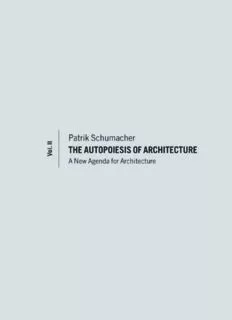
The Autopoiesis of Architecture, Volume II: A New Agenda for Architecture PDF
Preview The Autopoiesis of Architecture, Volume II: A New Agenda for Architecture
P1:TIX/XYZ P2:ABC JWBK521-fm JWBK521-Schumacher February9,2012 8:56 PrinterName: ToCome P1:TIX/XYZ P2:ABC JWBK521-fm JWBK521-Schumacher February9,2012 8:56 PrinterName: ToCome I I . THE AUTOPOIESIS OF ARCHITECTURE l o V P1:TIX/XYZ P2:ABC JWBK521-fm JWBK521-Schumacher February9,2012 8:56 PrinterName: ToCome To Zaha Hadid P1:TIX/XYZ P2:ABC JWBK521-fm JWBK521-Schumacher February9,2012 8:56 PrinterName: ToCome Patrik Schumacher I I . THE AUTOPOIESIS OF ARCHITECTURE l o V A New Agenda for Architecture A John Wiley & Sons, Ltd., Publication P1: TIX/XYZ P2: ABC JWBK521-fm JWBK521-Schumacher February 9, 2012 8:56 Printer Name: To Come This edition first published 2012 (cid:2)c 2012 John Wiley & Sons Ltd Registered Office John Wiley & Sons Ltd, The Atrium, Southern Gate, Chichester, West Sussex, PO19 8SQ, United Kingdom For details of our global editorial offices, for customer services and for information about how to apply for permission to reuse the copyright material in this book please see our website at www.wiley.com. The right of the author to be identified as the author of this work has been asserted in accordance with the Copyright, Designs and Patents Act 1988. All rights reserved. No part of this publication may be reproduced, stored in a retrieval system, or transmitted, in any form or by any means, electronic, mechanical, photocopying, recording or otherwise, except as permitted by the UK Copyright, Designs and Patents Act 1988, without the prior permission of the publisher. Wiley publishes in a variety of print and electronic formats and by print-on-demand. Some material included with standard print versions of this book may not be included in e-books or in print-on-demand. If this book refers to media such as a CD or DVD that is not included in the version you purchased, you may download this material at http://booksupport.wiley.com. For more information about Wiley products, visit www.wiley.com. Designationsusedbycompaniestodistinguishtheirproductsareoftenclaimedas trademarks.Allbrandnamesandproductnamesusedinthisbookaretradenames,service marks,trademarksorregisteredtrademarksoftheirrespectiveowners.Thepublisherisnot associatedwithanyproductorvendormentionedinthisbook.Thispublicationisdesigned toprovideaccurateandauthoritativeinformationinregardtothesubjectmattercovered.It issoldontheunderstandingthatthepublisherisnotengagedinrenderingprofessional services.Ifprofessionaladviceorotherexpertassistanceisrequired,theservicesofa competentprofessionalshouldbesought. ExecutiveCommissioningEditor:HelenCastle ProjectEditor:MiriamSwift AssistantEditor:CalverLezama ISBN978-0-470-66615-9(hardback) ISBN978-0-470-66616-6(paperback) ISBN978-1-119-94046-3(ebk) ISBN978-1-119-94047-0(ebk) ISBN978-1-119-94048-7(ebk) DesignandcoverdesignbyKateWard Typesetin9.5/12.5ptTradeGothicbyAptaraInc.,NewDelhi,India PrintedandboundinGreatBritainbyCPIAntonyRowe,Chippenham,Wiltshire P1:TIX/XYZ P2:ABC JWBK521-fm JWBK521-Schumacher February9,2012 8:56 PrinterName: ToCome Contents C O N T E N T IntroductiontoVolume2 1 S 6. TheTaskofArchitecture 5 6.1 Functions 7 6.1.1 FunctionsversusCapacities 11 6.1.2 SubstantialversusSubsidiaryFunctions 17 6.1.3 Tectonics 19 6.1.4 TheCategorizationofFunction-types 22 6.1.5 Problem-types(Function-types)vsSolution-types(Archetypes) 24 6.1.6 PatternsofDecomposition/Composition 30 6.1.7 FunctionalReasoningviaAction-artefactNetworks 32 6.1.8 LimitationsofFunctionalExpertise 39 6.2 OrderviaOrganizationandArticulation 42 6.2.1 OrganizationandArticulation:Historical andSystematic 47 6.2.2 ArchitecturalOrder 52 6.2.3 ADefinitionofOrganizationforContemporaryArchitecture 57 6.2.4 Complicated,Complex,Organized,Ordered 61 6.3 Organization 70 6.3.1 RelatingSpatialtoSocialOrganization 72 6.3.2 TerritorializationandIntegration 77 6.3.3 Systems,Configurations,Organizations 80 6.4 SupplementingArchitecturewithaScienceofConfiguration 88 6.4.1 SetTheory 88 6.4.2 HarnessingNetworkTheory 93 6.4.3 Excursion:NetworkTheory 99 6.4.4 ACityisnotaTree 106 6.4.5 SpaceSyntax:ConceptsandToolsofAnalysis 112 6.4.6 SpaceSyntax:TheoreticalClaims 125 6.4.7 FromOrganizationtoArticulation:TakingAccountofCognition 131 6.5 Articulation 134 6.5.1 ArticulationvsOrganization 134 6.5.2 TheProblemofOrientationandtheProblematic ofLegibility 137 6.5.3 ArticulatevsInarticulateOrganization 138 6.5.4 ArticulationastheCoreCompetencyofArchitecture 139 6.5.5 GeneralizingtheConceptofFunction 140 6.6 ThePhenomenologicalvstheSemiologicalDimensionofArchitecture 142 P1:TIX/XYZ P2:ABC JWBK521-fm JWBK521-Schumacher February9,2012 8:56 PrinterName: ToCome 6.7 ThePhenomenologicalDimensionofArchitecturalArticulation 145 6.7.1 ThePerceptualConstitutionofObjectsandSpaces 147 6.7.2 CognitivePrinciplesofGestalt-Perception 153 6.7.3 ParametricFiguration 165 6.8 TheSemiologicalDimensionofArchitecturalArticulation 167 6.8.1 TheBuiltWorksofArchitectureasFraming Communications 171 6.8.2 Analogy:LanguageandBuiltEnvironmentasMediaof Communication 176 6.8.3 SignsasCommunications 181 6.8.4 TerritoryasFundamentalSemiologicalUnit 183 6.8.5 Saussure’sInsight:LanguageasSystemofCorrelated Differences 189 6.8.6 Extra-SemiologicalDemandsonArchitecture’sMedial Substrate 193 6.8.7 SyntagmaticvsParadigmaticRelations 196 6.9 ProlegomenontoArchitecture’sSemiologicalProject 200 6.9.1 TheScopeofArchitecture’sSignified 201 6.9.2 TheCompositeCharacteroftheArchitecturalSign 206 6.9.3 AbsoluteandRelativeArbitrariness 210 6.9.4 NaturalandArtificialSemiosis 215 6.9.5 DesigningArchitecture’sSemiologicalProject 222 6.9.6 CognitiveandAttentionalConditionsofArchitectural Communication 229 6.9.7 Speculation:ExpandingtheExpressivePowerof ArchitecturalSignSystems 232 6.10 TheSemiologicalProjectandtheGeneralProjectof ArchitecturalOrder 238 6.10.1 TheSemiologicalProjectinRelationtotheOrganizational andthePhenomenologicalProject 239 6.10.2 RelationshipbetweenArchitecturalLanguagesand ArchitecturalStyles 244 6.10.3 TheRequisiteVarietyofArchitecturalArticulation 246 7. TheDesignProcess 251 7.1 ContemporaryContextandAimofDesignProcessTheory 254 7.2 TowardsaContemporaryDesignProcessReflectionand DesignMethodology 257 7.2.1 MethodvsProcess 258 7.3 TheDesignProcessasProblem-solvingProcess 263 7.3.1 TheDesignProcessasInformation-processingProcess 264 7.3.2 TheStructureofInformation-processingSystems 269 vi P1:TIX/XYZ P2:ABC JWBK521-fm JWBK521-Schumacher February9,2012 8:56 PrinterName: ToCome vii 7.3.3 Programmes 272 7.3.4 TheTaskEnvironmentanditsRepresentationas C ProblemSpace 277 O N T 7.3.5 ProblemSolvingasSearchinaStateSpace 284 E N 7.3.6 PlanningSpaces 295 TS 7.3.7 HeuristicversusExhaustiveProblem-solvingMethods 298 7.4 DifferentiatingClassical,ModernandContemporaryProcesses 311 7.5 ProblemDefinitionandProblemStructure 318 7.5.1 WickedProblems 319 7.5.2 TheStructureofIll-structuredProblems 323 7.5.3 AnInformation-processingModelforInformation-rich DesignProcesses 332 7.6 Rationality:RetrospectiveandProspective 337 7.6.1 RationalinRetrospect:ObservingInnovative DesignPractice 341 7.6.2 ProspectiveRationality 355 7.6.3 ProcessingtheThreeTaskDimensionsofArchitecture 358 7.7 ModellingSpaces 361 8. ArchitectureandSociety 379 8.1 WorldArchitecturewithinWorldSociety 382 8.2 AutonomyvsAuthority 385 8.3 Architecture’sConceptionofSociety 390 8.3.1 TheCrisisofModernism’sConceptionofSociety 394 8.3.2 SocialSystemsTheoryandtheTheoryofArchitectural Autopoiesis 396 8.4 ArchitectureinRelationtootherSocietalSubsystems 398 8.4.1 ArchitectureInRelationtotheEconomicSystem 401 8.4.2 TheEconomyandtheDesign-Principleof EconomyofMeans 402 8.4.3 EconomicConditionsofArchitecturalDiscourse 406 8.4.4 ArchitectureandEducation 407 8.5 ArchitectureasProfessionandProfessionalCareer 410 8.5.1 Authorship,Reputation,Oeuvre 411 8.5.2 Centre-peripheryDifferentiationwithinArchitecture 414 8.5.3 TheAbsorptionofUncertainty 418 8.5.4 TheArchitecturalDesignStudioasOrganization 420 8.6 TheBuiltEnvironmentasPrimordialConditionofSociety 422 8.6.1 TheBuiltEnvironmentAsIndispensableSubstrateof SocialEvolution 423 8.6.2 FromSpatialOrdertoConceptualOrder 426 8.6.3 BeautyandtheEvolutionofConceptsofOrder 434 P1:TIX/XYZ P2:ABC JWBK521-fm JWBK521-Schumacher February9,2012 8:56 PrinterName: ToCome 9. ArchitectureandPolitics 439 9.1 IsPoliticalArchitecturePossible? 440 9.1.1 PoliticalVacuum 441 9.1.2 NormalvsRevolutionaryPolitics 445 9.2 TheorizingtheRelationshipbetweenArchitectureandPolitics 448 9.2.1 TheIncommensurabilityofArchitecture andPolitics 448 9.2.2 ArchitectureRespondstoPolitical Agendas–ThreeScenarios 450 9.2.3 ServiceProvisionsBetweenArchitecture andPolitics 453 9.3 ArchitectureAdaptstoPoliticalDevelopment 459 9.3.1 ModernArchitectureCallsonPolitics 461 9.3.2 TheABCGroup:PoliticalAgitationWithinArchitecture 462 9.3.3 TheVicissitudesofPoliticalPolarization 466 9.4 TheLimitationsofCriticalPracticeinArchitecture 470 9.4.1 GeneralPoliticalCritiqueandMacro-politicalAmbitions 470 9.4.2 Architecture’s‘Micro-Political’Agency:Manipulating Non-politicalPower 472 9.4.3 WhoControlsthePower-distributing CapacityofDesign? 474 9.4.4 PublicCompetitionsAsStructuralCouplingbetween ArchitectureandPolitics 477 10. TheSelf-descriptionsofArchitecture 484 10.1 TheoreticalUnderpinnings 485 10.1.1 ReferenceasSelf-reference 489 10.1.2 LevelsofSelf-reference 490 10.2 TheNecessityofReflection:ArchitecturalTheoryas ReflectionTheory 496 10.2.1 ContinuityvsConsistency 501 10.2.2 CategoricalvsVariableStructures ofCommunication 504 10.3 ClassicTreatises 509 10.3.1 Alberti’sDereaedificatoria 511 10.3.2 Durand’sPre´cisdeslec¸onsd’architecture 543 10.3.3 LeCorbusier’sVersunearchitecture 568 10.3.4 TheAutopoiesisofArchitecture 592 10.4 ArchitecturalHistoriography 606 10.4.1 HistoryofArchitecture’sAutonomizationand InternalStructuration 608 viii
Description: